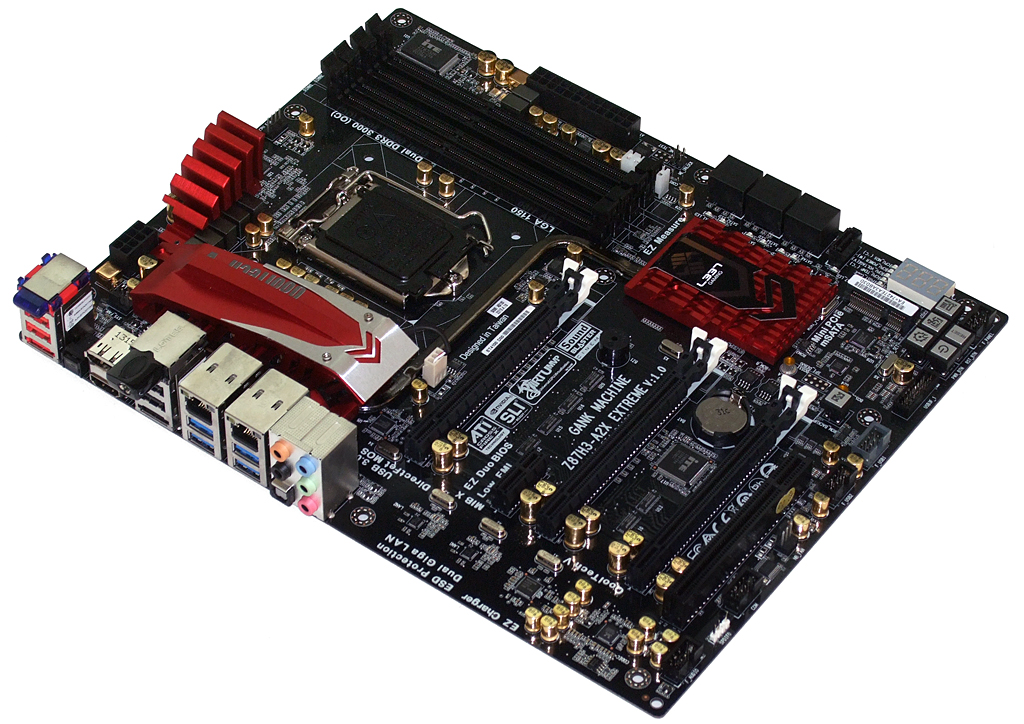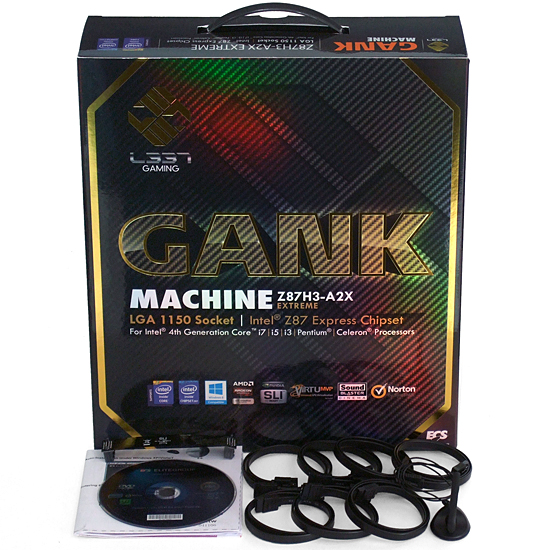Five Z87 Motherboards Under $220, Reviewed
Intel’s Haswell architecture displaces Ivy Bridge in its desktop line-up, bringing with it yet another new CPU interface. We tested six motherboards that claimed to be ready for your overclocking efforts, and included the five survivors in today’s review.
ECS Z87H3-A2X Extreme
Why you can trust Tom's Hardware
ECS’s $240 Z87-A2X Extreme “goes large” with features, adding a single-band USB-based 802.11n Wi-Fi and Bluetooth controller with its dual-gigabit Ethernet capability. But wait, isn’t this a sub-$220 round-up?
After initially disclosing a $220 MSRP, ECS decided to add a $50 game bundle to this board and increase its price by $20. That could be a bargain, depending on the titles, but would have also excluded this product from today’s round-up. Knowing that, ECS is applying a $20 temporary discount to the board. Thanks to the discount, June buyers get both the original $220 price and the promised game certificate.
Other I/O panel features include a CLR_CMOS button, dual eSATA, DisplayPort, and HDMI. Separate front and rear controllers make all four added-in SATA ports function simultaneously.
The Z87H3-A2X Extreme’s extra internal ports aren’t as noticeable as competing solutions, since one of its connectors is perpendicular to the motherboard and the other connects to an mSATA slot. With mSATA drives now exceeding 256 GB, builders who dislike drive cables can build without them, and expect fairly comparable performance.
Buyers who like on-board buttons will be thrilled with the Z87H3-A2X’s bottom-front corner, finding power, reset, boot-to-UEFI, overclocking profile, and diagnostics display mode switches next to a three-digit panel. The diagnostic ouput can display POST code, CPU TDP, CPU voltage, CPU wattage, or CPU MOS temperature readings.
A five-pin connector next to the DIMM slots is designed to hold volt meter probes for verifying CPU core, DIMM, PCH, and PCH I/O voltage levels. If we’ve learned anything about motherboard monitoring of DIMM voltage, it’s never to trust and always to verify.
ECS configures the Z87H3-A2X Extreme’s slots to support up to three-way graphics arrays, and even spaces its slots to allow a trio of double-space cards to fit within an ATX case’s seven spaces. These slots automatically switch from x16-x0-x0 to x8-x8-x0 and x8-x4-x4 transfer modes as the next long slot is filled. Though the bandwidth boost of PCIe 3.0 makes four-lane transfers acceptable to many builders, those who'd rather put a slower card in the third slot might be upset when the first slot drops to eight and the middle to four lanes. This is always going to be a tradeoff when only 16 third-gen lanes exist.
ECS places its USB 3.0 internal header along the motherboard’s bottom edge, which could have been a problem if its hadn’t moved all of the platform's PCIe slots further up on the board compared to competitors. The slot move is a great idea in my opinion, though I can imagine other reviewers are going to ask for more space around the DIMM latches.
Our only true layout concern is that the front-panel audio connector is tucked a little too far into the bottom rear corner for the reach of some front-panel cables. Our solution is to buy a better case.
Though I haven’t seen anyone get ganked since the second millennium, I was amused to find the term re-emerge in certain gaming and entertainment circles. ECS includes a full set of SATA cables, a flexible SLI bridge, and a Wi-Fi antenna inside the Z87H3-A2X Extreme's colorfully-named box.
Current page: ECS Z87H3-A2X Extreme
Prev Page Z87-Pro Applications Next Page Z87H3-A2X Extreme FirmwareGet Tom's Hardware's best news and in-depth reviews, straight to your inbox.
-
Someone Somewhere Who did you get the CPU from? Given the Haswell launch article said they were unlikely to be able to hit 4.5GHz+, is this a cherry-picked chip from Intel?Reply
Could we see some MBs around the $130-$140 mark? They're the interesting ones IMO, and would toast most of these in terms of value. -
Crashman Reply
Intel says it doesn't cherry-pick chips for reviewers...10911132 said:Who did you get the CPU from? Given the Haswell launch article said they were unlikely to be able to hit 4.5GHz+, is this a cherry-picked chip from Intel?
-
Memnarchon Thank you. I was looking forward for a review like this. I read some reviews and the o/c was varying from mobo to mobo lot. So if the same cpu was used, 4,3Ghz to 4,7Ghz is a lot of difference. Because if your cpu would o/c to 4,3Ghz most we would tell its a crap sample Haswell sucks on o/c etc etc, but if it was be able to clock to 4,7Ghz we would say its a nice sample.Reply -
cangelini Reply
Yes, the CPU comes from Intel. Almost certainly it was cherry-picked. But this is why we didn't rely on these CPUs for our launch coverage--it makes a lot more sense to go to a source with hundreds of boxed processors on the bench to get a real sense for what Haswell will do in the wild. At least for this round-up, the variable changing is the motherboard. So, we derive as much meaning as possible with a review sample that hits 4.7 GHz on one board and 4.5 GHz on another.10911132 said:Who did you get the CPU from? Given the Haswell launch article said they were unlikely to be able to hit 4.5GHz+, is this a cherry-picked chip from Intel?
Could we see some MBs around the $130-$140 mark? They're the interesting ones IMO, and would toast most of these in terms of value.
-
Someone Somewhere Yeah - but if people think that their chip is going to hit 4.7 on a good board, then find they can't get 4.5, they can be upset.Reply
OTOH, the launch coverage said that was at 1.2V, while this is 1.3V, so I guess a few hundred MHz extra is reasonable.
Lot more variation than on IB's review: http://media.bestofmicro.com/X/O/335580/original/image019.png -
JOSHSKORN Isn't there a flaw in the Z87 technology regarding sleep mode? Was it mentioned in the article? I didn't see it.Reply -
Jason Louie do these board suffer from the rumoured usb3 sleep issue? or are they the fixed B3 steppings ?Reply -
Crashman Reply
Did you read the Haswell review? All current boards are affected, no future boards will be, there's nothing to update here, and the flaw is virtually meaningless.10911218 said:Isn't there a flaw in the Z87 technology regarding sleep mode? Was it mentioned in the article? I didn't see it.
http://www.tomshardware.com/reviews/core-i7-4770k-haswell-review,3521-9.html
If you have one of the affected drives and can't be bothered to reconnect it when it goes offline, wait a couple weeks and buy a board from the new batch.
The differences between boards in today's review are overclocking, power consumption, and onboard features. None of those things will change with the new PCH batch, and firmware updates should improve both batches equally.
-
Jason Louie do these board suffer from the rumoured usb3 sleep issue? or are they the fixed B3 steppings ?Reply -
sna Hello,Reply
Can you guys please test 6 SSD in Raid 0 on these mobos ? this is the only Advantage of upgrading to a Haswell over ivy/sandy bridge.



